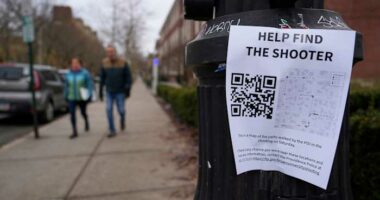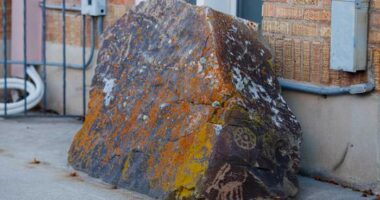Share this @internewscast.com

For six long years, Ruth Wilson endured the frustration of misdiagnoses as doctor after doctor dismissed her persistent symptoms, which included rashes, swelling, fevers, and severe pain. It was only after she pleaded for one final test in the emergency room—just as she was about to be sent home without any answers—that her life took a pivotal turn.
This crucial test revealed that Wilson’s kidneys were failing. The underlying cause? Her immune system had been mistakenly attacking her own body all along, a fact that had previously gone unnoticed.
“I just wish there was a more straightforward way for patients to receive a diagnosis without enduring all the pain, dismissiveness, and gaslighting,” she expressed.
Wilson was ultimately diagnosed with lupus, a condition often referred to as the “disease of 1,000 faces” due to its diverse range of symptoms. Her experience highlights the perplexing nature of autoimmune disorders, which affect an estimated 50 million Americans and millions more around the globe. These diseases remain difficult to treat, are on the rise, and continue to baffle the medical community.
However, there is a glimmer of hope on the horizon. Drawing on advancements from cancer research and insights gained during the COVID-19 pandemic, scientists are making strides in understanding the biology of these debilitating conditions. They are identifying the pathways that lead to various autoimmune diseases and discovering connections between seemingly unrelated conditions, with the aim of addressing the root causes rather than merely alleviating symptoms.
This ambitious endeavor is challenging. The immune system’s misguided attacks can damage nerves in multiple sclerosis, inflame joints in rheumatoid arthritis, dry out the eyes and mouth in Sjögren’s syndrome, destroy insulin-producing cells in Type 1 diabetes, weaken muscles in conditions like myositis and myasthenia gravis, and wreak systemic havoc in lupus.
The list goes on: A new count from the National Institutes of Health tallied 140 autoimmune conditions, many rare but altogether a leading cause of chronic disease that’s often invisible.
“You look normal. People see you and they don’t think you have this horrible disease,” said Wilson, 43, who balances her illness with volunteering to help educate the public and even doctors about life with lupus.
While there’s still an enormous amount to learn, recent steps have some specialists daring to wonder if just maybe, ways to cure or prevent at least some of these diseases are getting closer.
In dozens of clinical trials, scientists are harnessing some of patients’ own immune cells to wipe out wayward ones that fuel lupus and a growing list of other diseases. It’s called CAR-T therapy and early results with these “living drugs” are promising. The first lupus patient was treated in Germany in March 2021 and remains in drug-free remission, the researchers said last month.
And a drug named teplizumab can delay the start of Type 1 diabetes symptoms in people destined to get sick, buying some time before they’ll need insulin. Citing that “tantalizing evidence,” the NIH’s new five-year plan for autoimmune research — if it gets funded — urges pursuing similar windows to intervene in other simmering diseases.
“This is probably the most exciting time that we’ve ever had to be in autoimmunity,” said Dr. Amit Saxena, a rheumatologist at NYU Langone Health.
Inside job
Your immune system has multiple overlapping ways to detect and attack bacteria, viruses or other bad actors. That includes teaching key soldiers — T cells and antibody-producing B cells — how to distinguish what’s foreign from what’s “you.”
It’s a delicate balancing act, especially considering germs sometimes adapt features similar to human molecules so they can confuse and sneak past immune defenses. And while the immune system has built-in safeguards to curtail any misbehaving cells, autoimmune diseases set in when the system gets off-kilter.
Numerous genes involved in different immune functions can make people susceptible to common autoimmune diseases. That means if one family member is sick, others may be at increased risk. Such genes can include variants that once protected our ancestors from long-ago threats including the Black Death but that today can translate into a hyperactive immune system.
But “genes are not everything,” said Dr. Mariana Kaplan of NIH’s National Institute of Arthritis and Musculoskeletal and Skin Diseases.
Studies show if one identical twin develops an autoimmune disease, the other isn’t guaranteed to get sick. Non-genetic factors that trigger an immune response play a big role, such as infections, certain medicines, smoking, pollutants. In lupus, even a bad sunburn is suspect.
“At some point there is a second or third hit and the immune system says, ‘That’s it, I can’t handle any more of these insults,’” said Kaplan, who directs systemic autoimmunity research.
And women are more likely to get autoimmune diseases than men, maybe because of estrogen or their extra X chromosome. That’s especially evident in lupus; women account for 90% of cases, often young ones like Wilson.
Fainting spells and body-wide rashes began in her 20s and intensified with two pregnancies. Youngsters in tow, she saw a variety of doctors for fevers, swelling, joint and back pain until that fateful ER visit when she requested a urine test.
Months of grueling treatment saved her kidneys. But over a decade later, the Littleton, Massachusetts, woman still lives with daily pain from lupus. Deep fatigue and brain fog — difficulty with concentrating, short-term recall, multitasking — wax and wane.
Therapies have improved in recent years, from high-dose steroids and drugs that broadly suppress the immune system to include additional options that focus on specific molecules. Wilson gets a monthly lupus-targeted IV treatment and takes about six daily medicines to calm her overactive immune system and related symptoms.
Worse are what are called flares, when symptoms abruptly and markedly worsen. For Wilson, they bring sudden high fevers, legs too swollen to walk, more intense pain, lasting days to a week. They impact her job at a medical lab and time with her husband, teen son and college-age daughter.
“It’s not a bad life, it’s just a bad day,” she tells herself to get through.
Kaplan, the NIH scientist, has a biological explanation for the daily slog: The same inflammatory proteins that cause aches and fatigue during a cold or flu continually course through the bodies of patients with systemic autoimmune diseases like lupus.
Hunting the root causes
“These are my babies,” said Dr. Justin Kwong, a research fellow in Kaplan’s lab at NIH, as he carefully examines cells in an incubator.
Kwong is performing something so tricky it’s not done in many laboratories: He’s growing batches of neutrophils, the body’s most common white blood cells.
They are first responders that race to the site of an injury or infection, and Kaplan suspects they’re among the earliest immune cells to run amok and trigger certain autoimmune diseases.
How? Some types of neutrophils spew out their insides to form sticky spider-web like structures that trap and kill germs. The neutrophils die in the process.
But patients with lupus and some other diseases harbor abnormal neutrophils that form too many webs, Kaplan said. Her team is investigating if other immune defenses mistakenly sense the resulting debris as foreign, sparking a chain reaction.
“We think that’s a fundamental initial process,” Kaplan said. “We’re trying to find why it happens, why it happens more often in women, and can we come up with strategies to stop this without harming the way we defend ourselves from infections.”
Another common feature: Patients with a number of autoimmune diseases, especially women, often suffer heart attacks and strokes at unusually young ages. Kaplan’s research suggests those aptly named NETS, or neutrophil extracellular traps, may be key — by damaging blood vessels and spurring hardened arteries typically seen in older people.
But neutrophils don’t live long outside the body and testing mature ones from lupus patients’ blood won’t show how they went awry — something Kwong’s baby neutrophils may aid.
Teasing apart patient differences
Whatever triggers it, lupus has bafflingly varied symptoms and treatments that can keep some patients symptom-free but not others.
That suggests “lupus is not a single disease,” Kaplan said. “What we call lupus probably represents many different conditions that have some common factors.”
How to subtype lupus isn’t clear. But another disease, rheumatoid arthritis, may offer clues. Perhaps best recognized by painfully disfigured fingers, RA can attack any joint and even some organs, sometimes scarring lungs.
Like with lupus, RA treatment is trial-and-error and scientists are exploring different underlying factors to explain why. In one study, an international team used tiny samples of patients’ joint tissue to identify six inflammatory subtypes of RA based on patterns of cells, how they clustered and their activity.
It “changed how we think about the disease,” said Northwestern University rheumatology chief Harris Perlman, one of the coauthors. Now researchers are comparing cells in joint tissue before and after patients start a new drug to see if they could help guide treatment choices, he said.
Living with lupus
Wilson learned to wear sunscreen and a big hat outdoors and how to ration her energy in hopes of avoiding flares. When her kids were old enough for school, she returned, too, getting degrees that led to laboratory research and data science jobs — and a better understanding of her own disease and its treatments.
One day her then-rheumatologist asked if she’d answer some medical students’ questions. Wilson remembers many knew “what lupus looks like in a textbook” but not the patient perspective.
“I realized, my god, I need to start talking about this.”
What that looks like now: One evening last February, Wilson bubbled with nerves and excitement at finally meeting some members of her online lupus support group. At UMass Chan Medical School, Wilson greeted the two women and two men with hugs. They shared symptoms and treatments — and rueful stories of well-meaning relatives urging them to just get more sleep to combat the lupus fatigue that rest can’t conquer.
A month later, Wilson traveled to Washington for a meeting organized by the Lupus Research Alliance, where she urged scientists and drug company researchers to heed patient reports of changes in their everyday lives, such as whether a new therapy helps brain fog.
Drug studies that measure physical symptoms and blood markers are “only capturing half the story,” she said. “If a treatment allows me to think clearly, to engage in my life, to be the person I know I am beneath all of this, then that is just as important as reducing inflammation.”
While her doctor isn’t recommending experimental treatments yet, Wilson recently joined the Lupus Landmark Study that will track biological samples from 3,500 patients to better understand disease variations. Whenever a flare strikes Wilson pricks her finger for a blood sample to share.
“It’s important for me to also be a voice for patients because I think of myself and how lonely I was at the very beginning,” Wilson said. For a long time, “I never wanted to talk about it. Especially my kids, I wanted them to know that I was going to be OK. And so you put on your makeup and your lipstick and your three shades of eye corrector and you go on.”
___
The Associated Press Health and Science Department receives support from the Howard Hughes Medical Institute’s Department of Science Education and the Robert Wood Johnson Foundation. The AP is solely responsible for all content.
Copyright 2025 The Associated Press. All rights reserved. This material may not be published, broadcast, rewritten or redistributed without permission.













